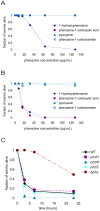Identification of Pseudomonas aeruginosa phenazines that kill Caenorhabditis elegans
- PMID: 23300454
- PMCID: PMC3536714
- DOI: 10.1371/journal.ppat.1003101
Identification of Pseudomonas aeruginosa phenazines that kill Caenorhabditis elegans
Abstract
Pathogenic microbes employ a variety of methods to overcome host defenses, including the production and dispersal of molecules that are toxic to their hosts. Pseudomonas aeruginosa, a Gram-negative bacterium, is a pathogen of a diverse variety of hosts including mammals and the nematode Caenorhabditis elegans. In this study, we identify three small molecules in the phenazine class that are produced by P. aeruginosa strain PA14 that are toxic to C. elegans. We demonstrate that 1-hydroxyphenazine, phenazine-1-carboxylic acid, and pyocyanin are capable of killing nematodes in a matter of hours. 1-hydroxyphenazine is toxic over a wide pH range, whereas the toxicities of phenazine-1-carboxylic acid and pyocyanin are pH-dependent at non-overlapping pH ranges. We found that acidification of the growth medium by PA14 activates the toxicity of phenazine-1-carboxylic acid, which is the primary toxic agent towards C. elegans in our assay. Pyocyanin is not toxic under acidic conditions and 1-hydroxyphenazine is produced at concentrations too low to kill C. elegans. These results suggest a role for phenazine-1-carboxylic acid in mammalian pathogenesis because PA14 mutants deficient in phenazine production have been shown to be defective in pathogenesis in mice. More generally, these data demonstrate how diversity within a class of metabolites could affect bacterial toxicity in different environmental niches.
Conflict of interest statement
The authors have declared that no competing interests exist.
Figures




References
-
- de Vrankrijker AM, Wolfs TF, van der Ent CK (2010) Challenging and emerging pathogens in cystic fibrosis. Paediatr Respir Rev 11: 246–254. - PubMed
-
- Williams BJ, Dehnbostel J, Blackwell TS (2010) Pseudomonas aeruginosa: host defence in lung diseases. Respirology 15: 1037–1056. - PubMed
-
- Bleves S, Viarre V, Salacha R, Michel GP, Filloux A, et al. (2010) Protein secretion systems in Pseudomonas aeruginosa: A wealth of pathogenic weapons. Int J Med Microbiol 300: 534–543. - PubMed
Publication types
MeSH terms
Substances
Grants and funding
LinkOut - more resources
Full Text Sources
Other Literature Sources

